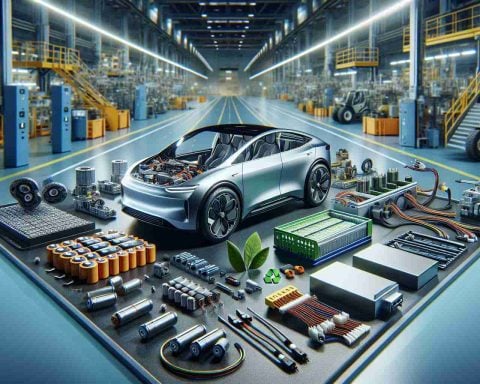- The UK leads Europe in battery storage, with 6GW/8GWh on-grid and 20GWh to be added soon.
- The Energy Storage Summit EU gathers global energy experts to explore the future of energy storage in Europe.
- Key speakers, such as Duncan Stone and Mike Thompson, will discuss the UK’s energy market dynamics and pathways.
- Brent Wanner will address the EU’s ambitious goal of 200GW energy storage by 2030.
- Panels will analyze market trends, European strategic landscapes, and risk assessments for future investments.
- Technological innovations, AI integration, and utility-scale storage will be major focus areas.
- The summit emphasizes that while technology is critical, a robust business framework is essential for progress.
- Energy storage is pivotal in addressing energy and climate challenges, offering a sustainable future path.
Amidst the bustling streets of London, a gathering of global energy visionaries awaits at the Energy Storage Summit EU. The UK, Europe’s leader in large-scale battery storage, now hums with 6GW/8GWh on its grid and nearly 20GWh poised to come online. This summit promises a deep dive into the future of energy storage across the continent.
Delegates from various corners of the earth will glean insights from luminaries like Duncan Stone of the UK Department for Energy Security & Net Zero, who will unravel the nuanced dynamics of the UK market, and Mike Thompson from the National Energy System Operator, who has a finger on the pulse of Great Britain’s energy pathways. But the scope of the summit extends beyond British borders. Brent Wanner from the International Energy Agency will tackle the ambitious 200GW energy storage target set by the EU for 2030.
Incisive panels are scheduled, where experts will dissect market trends, the strategic landscape for northern and southern Europe, and critical risk assessments. These discussions aim to sculpt a business template for future investments in this thriving sector.
Underneath the headlines lies the heartbeat of the industry: technology. Attendees are set to peruse a smorgasbord of sessions covering advances in safety, design innovations, and the potent integration of AI. Utility-scale storage and its transformative potential are expected to dominate conversations, alongside co-location strategies with renewables.
Yet, the real takeaway from this vibrant summit is clear: while technology shapes the future, the actual battleground is the business framework enabling these innovations. As the world stands at a crossroads of energy and climate crises, energy storage could emerge as its unsung hero, pushing the boundaries of what is possible to create a sustainable future. For those ready to lead the charge, the Energy Storage Summit EU is the starting line.
Revolutionary Insights at the Energy Storage Summit: How European Experts are Charting a New Future
The Energy Storage Summit EU in London is a pivotal event not only because it houses leaders in the energy sector but also because it illuminates new pathways and prospects for the future of energy storage in Europe and beyond. While the original article offers a comprehensive overview of the event, there are several key aspects and developments that enhance the overall understanding of this evolving industry.
Additional Insights on Energy Storage
1. UK’s Current Energy Goals and Challenges:
– The UK aims to achieve net-zero carbon emissions by 2050. Energy storage will play a critical role in meeting these targets. Efforts are increasingly focused on pairing renewable energy sources like wind and solar with advanced battery technologies to ensure reliability and grid stability.
2. EU’s Ambitious Energy Storage Target:
– The EU’s target of achieving 200GW of energy storage by 2030 is part of the broader European Green Deal, which aims to make Europe the first climate-neutral continent by 2050. This involves significant investments in renewable energy infrastructure and energy efficiency measures.
3. Innovations in Battery Technology:
– Emerging technologies such as solid-state batteries and flow batteries are promising substantial increases in energy density and safety over traditional lithium-ion batteries. These innovations could address some of the persistent challenges related to battery cost and sustainability.
4. Role of Artificial Intelligence:
– AI is seen as a game-changer in energy management. By optimizing how storage systems are utilized and predicting energy demand patterns, AI enhances efficiency and reduces operational costs, benefiting both providers and consumers.
Important Questions Explored
– What impact will Brexit have on the UK’s collaboration with the EU on energy storage?
– While Brexit presents regulatory challenges, it has not significantly deterred collaborations. Joint ventures and partnerships have continued to progress due to the common interest in developing sustainable energy solutions.
– How is energy storage influencing job creation in the energy sector?
– The proliferation of energy storage systems boosts job creation in manufacturing, installation, and maintenance of battery systems. The increased demand for skilled technicians and engineers is expected to grow as the sector expands.
– What are the main hurdles faced by the energy storage industry?
– The sector grapples with issues such as regulatory barriers, high initial investment costs, and the need for robust recycling programs for old batteries to maintain environmental sustainability.
Suggested Related Links
– International Energy Agency: Information on global energy policies, including reports and data on energy storage.
– National Energy System Operator: Insights into the UK’s energy grid and future energy plans.
– Energy Storage Journal: Updates and analysis on advancements and trends in energy storage technologies.
This summit highlights not only technological advancements but also underscores the critical importance of establishing a robust business framework to support these innovations, ensuring a sustainable energy future underscored by efficiency and collaboration globally.













